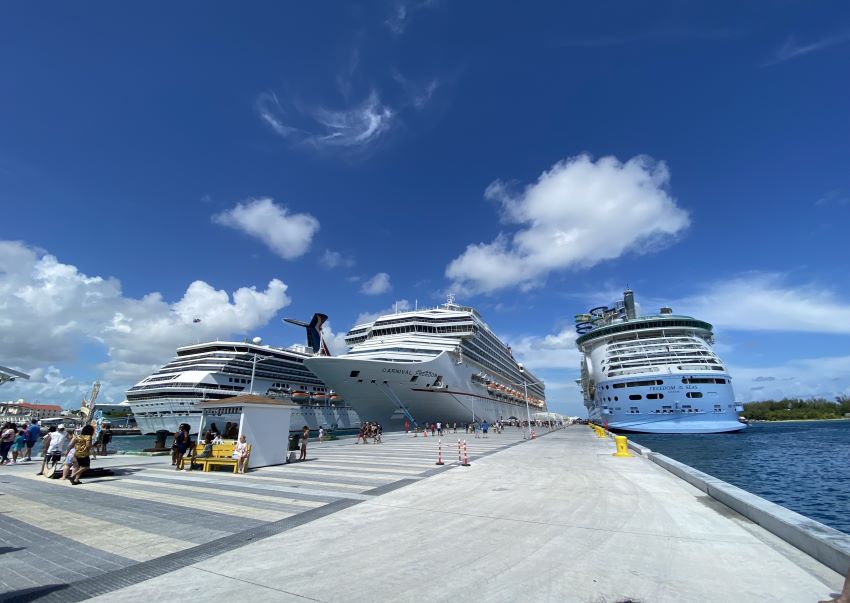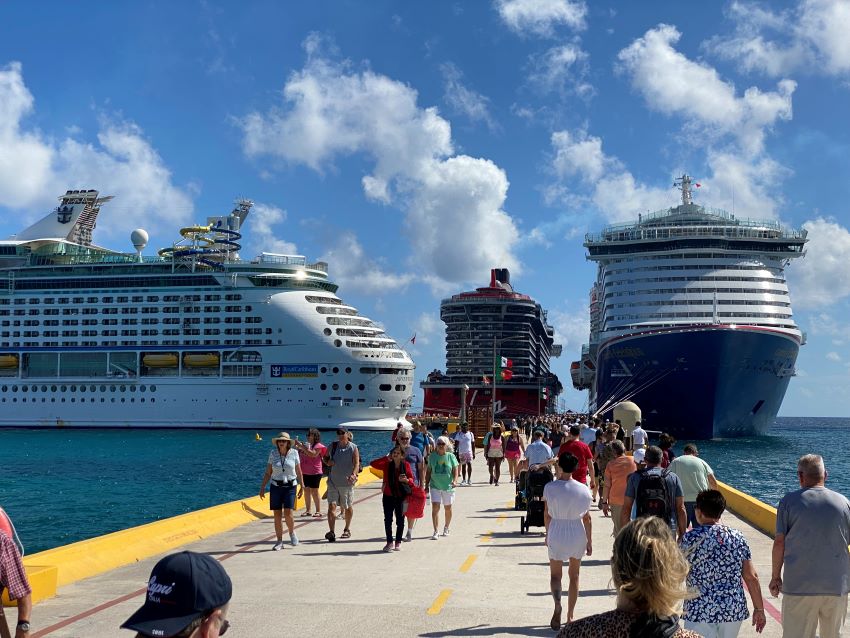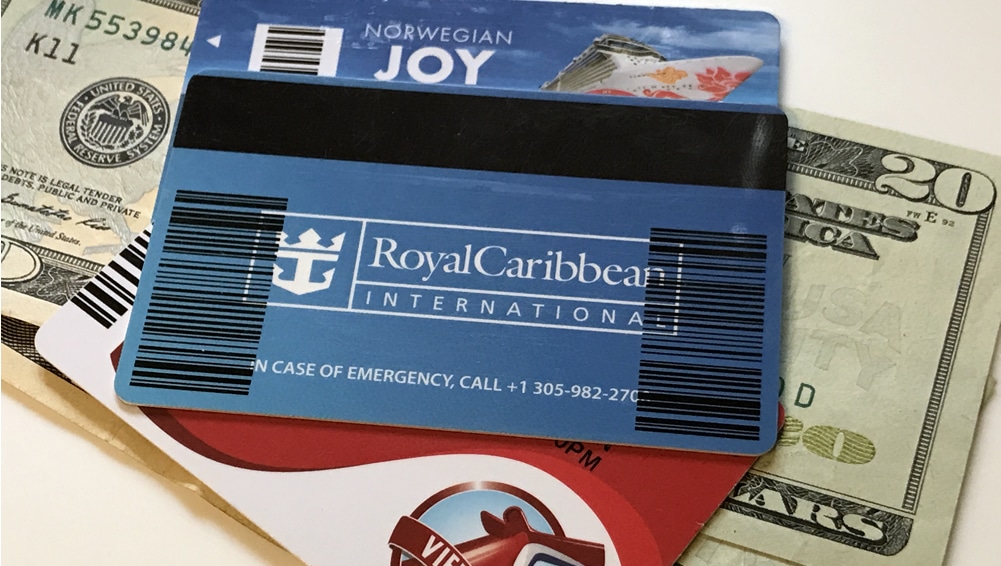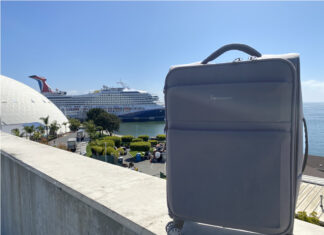One of the big benefits of a cruise is that it can be among the best values in vacations. A typical trip to the Caribbean, Europe, or Alaska would mean buying flights, booking hotels, reserving restaurants, scheduling entertainment… and then paying for it all individually.

A cruise can offer your transportation, room, board, and entertainment all in one price that’s considerably less than if you booked it all on your own.
Don’t confuse value with cheap, however. Cruise passengers still spend a considerable amount on their vacations, and the price has gone higher in recent years.
So how much do cruise passengers spend on a day-by-day basis? We dove into the actual metrics reported by the cruise lines themselves to get the answer.
Cheap Headline Prices… But Passengers Spend Much More
Anyone that’s bought a cruise before knows the costs can add up. Many lines advertise attractive “headline” fares that can be as low as a few hundred dollars for a week on the ship. The true cost, however, is significantly higher.
First, rooms are sold at double occupancy so the headline price is doubled right off the bat. Then there are higher charges for higher-end rooms like balconies or suites. Add to that the costs like port fees and taxes, as well as gratuities.
Then you have onboard expenses like specialty restaurants, shore excursions, wi-fi, shopping, and gambling in the casino.
When it’s all added up, it’s not unusual for your cruise to end up costing 3-4 times the cost of the headline price.
Of course, not all the money goes to the cruise line. For instance, gratuities are distributed among staff. Port fees are also dispersed. Shore excursions generate revenue, but it’s also shared with the tour provider.
What the cruise line does keep, however, is significant.
Cruise Lines Earn Billions in Revenue Annually

To passengers, it’s a great vacation. For cruise lines, it’s something completely different — a 24/7, 365-day a year battle for your cruise dollars. It’s the efforts of literally hundreds of thousands of people all designed to give you the perfect vacation and bring in literally billions of dollars in return.
Much like the car industry has brands to fit different segments that then roll up to a parent company, the cruise industry is dominated by just a handful of major players, albeit with several cruise lines each.
The smallest of the three is Norwegian Cruise Line Holdings. Across lines, its fleet measured 29 ships at the end of 2022, with three more coming online in 2023. According to financial statements, in the past 12 months those ships have generated $7.2 billion in revenue.
Royal Caribbean Group is considerably larger. The cruise company has more than 60 ships, with two more coming online in 2023 and its newest mega-ship — Icon of the Seas — taking on passengers in early 2024. In the past year, statements show the company has earned revenue of $12.0 billion.
But the largest cruise company is Carnival Corporation. At the end of 2022, Carnival had a passenger capacity of more than 250,000 people across 91 ships and several brands. In the past four quarters, financial records disclose the company brought in roughly $17.5 billion in revenue.
Three companies, combined to earn nearly $37 billion in revenue in a single year. And as more passengers set sail in the years to come, that figure will only grow larger.
How Much Cruises Earn on a Per Passenger Day Basis
If that sounds like a lot of money, it is. But cruise lines also take on a lot of passengers. So how much money do those passengers spend on the average day? We dug into the numbers to see.
The three major cruise companies — Norwegian, Royal Caribbean, and Carnival — are all publicly-traded. These major players report data such as revenue and passenger numbers to investors.
Digging through, we can calculate exactly how much cruise companies make per day on the basis of an individual passenger. We simply need to take total revenue and divide it by the “passenger cruise days.”
Passenger cruise days is simply a measure of each passenger multiplied by the length of their cruise. So a couple traveling on a 7-day cruise would add up to 14 passenger cruise days.
Dividing revenue by this figure arrives at home much the cruise lines take in on average from each passenger for each day on the ship. Take a look:
(Note: Due to the scheduling of reporting, 2023 data is incomplete. Our 2023 figures use the latest data available -- the first nine months of the year for Carnival Corporation and the first six months for Royal Caribbean and Norwegian.)
One thing to keep in mind is that these figures are for the parent company -- not the specific cruise line. For instance, Carnival Corporation is the parent of Carnival Cruise Line, Princess, Costa, and others. Royal Caribbean includes Royal Caribbean International, Celebrity, and more.
While the figures that go into these numbers -- such as total revenue and passenger cruise days -- have been a roller coaster due to the pandemic, the average revenue per passenger for each day on the ship has steadily increased.
Carnival Corporation: In 2018, Carnival Corporation generated revenue of $211 per passenger cruise day. That's steadily risen, with the first nine months of 2023 seeing a daily rate of $239 per day.
Royal Caribbean Group: Royal Caribbean is one of the biggest names in cruising. It's popular Royal Caribbean International brand is the most famous, but the company also includes Celebrity and others. In 2018, the company earned revenue of $227 per passenger day, which has steadily increased. Through the first half of 2023 (the latest data available), the figure now stands at nearly $270 per passenger day.
Norwegian Cruise Line Holdings: Famous for its NCL and Oceania lines, the company saw revenue per passenger day of nearly $299 in 2018. That figure peaked at nearly $380 in 2022. Through the first half of 2023 (the latest data available), revenue per passenger day eased slightly to $357.
Rising Costs... But Not Keeping With Inflation?

It's clear that the revenue earned per passenger day has steadily increased over the past few years. What's surprising is considering the inflation we've seen in daily life, these price increases are relatively mild.
Here is the total revenue per passenger day increase from 2018 through 2023:
- Carnival Corporation: 13.4%
- Royal Caribbean Group: 18.8%
- Norwegian Cruise Line Holdings: 19.6%
During that same time period, general inflation is up 21% according to data from the Minneapolis Federal Reserve.
In other words, while the cost for passengers have risen, the increase in the cost per day is actually lower than the overall inflation rate.
So while it may not always be cheap, the numbers point to cruising still offering a good value.






